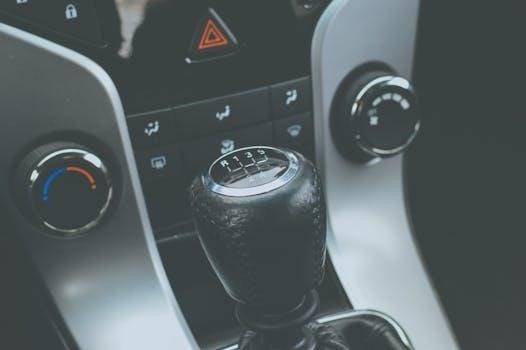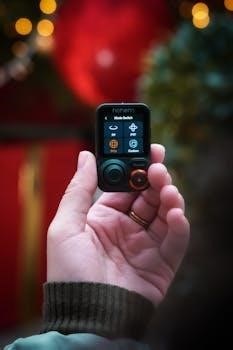Here’s the requested section⁚
KE2 Controller Manual PDF⁚ An Overview
This section offers a general introduction to KE2 controller manuals in PDF format. These manuals are crucial for understanding the installation, operation, and troubleshooting aspects of KE2 Therm refrigeration controllers. They provide comprehensive details for various models and applications.
Here’s the requested section⁚
Understanding KE2 Therm Solutions
KE2 Therm Solutions is a US-based developer and manufacturer specializing in smart refrigeration controllers and systems. Their leading-edge technology is widely specified by end-users, consultants, and major OEM manufacturers of evaporators, walk-in freezers, and coolers. KE2 Therm offers a comprehensive product line designed to optimize energy efficiency and provide precise control in commercial refrigeration applications.
Understanding KE2 Therm solutions involves recognizing their commitment to innovation and sustainability. Their controllers are engineered to save energy through features like precise superheat control, fan cycling, and demand defrost. KE2 Therm’s solutions aim to simplify installation and provide remote monitoring capabilities, enhancing overall system management and reducing operational costs for users in diverse industries.
Here’s the requested section⁚
KE2 Controller Types and Applications
KE2 Therm offers a diverse range of controllers tailored for various refrigeration needs. These include evaporator efficiency controllers, valve control systems, and air defrost controllers, each designed for specific applications and optimal performance.
Here’s the requested section⁚
KE2 Evaporator Efficiency (KE2 Evap) Controllers
KE2 Evap controllers are designed to optimize energy savings in refrigeration systems. By precisely managing superheat, space temperature, and fan cycling, these controllers minimize compressor runtime. They also implement demand defrosts, further enhancing efficiency.
These controllers, like the KE2 Evap-RE2, can be remotely accessed and monitored. The KE2 Adaptive Control kit (pn 21177) includes components necessary for installation, such as temperature sensors and safety shields. Installation instructions (N.1.1 July 2015) provide detailed guidance.
Using KE2 Smart Access simplifies setup and provides alarm notifications. Benefits include reduced IT support needs and remote monitoring capabilities. The controllers contribute to overall system performance by reducing energy consumption. This makes them a crucial component for commercial refrigeration systems.
Here’s the requested section⁚
KE2 Temp Valve Control
The KE2 Temp Valve Control simplifies installation by replacing traditional thermostats and defrost time clocks in air defrost applications. It also drives an electronic expansion valve (EEV) for precise refrigerant flow control. The KE2 Temp Valve Control includes RS-485 Modbus communications.
This allows for remote access using the KE2 Local Area Dashboard and Alarms (KE2 LDA). Installation manual N.1.301 Q4 January 2021 should remain on-site. The controller is designed for various applications, offering flexibility in installation locations.
For protection of the system, access to setpoint and manual control requires an installer password. Manual valve control is possible, allowing adjustment of valve opening percentage. This feature is accessed by holding the BACK button. The KE2 Temp Valve enhances system performance by providing accurate and reliable temperature management.
Here’s the requested section⁚
KE2 Temp Air Defrost Controllers
The KE2 Temp Air Defrost controller, model pn 20611, is designed for medium-temperature applications utilizing air defrost. Its installation manual provides comprehensive wiring instructions. The controller accepts both 120V/208-240V for power and 12V-240V solenoid voltage through the liquid line solenoid relay.
The KE2 Temp Air Defrost manual should remain on site with the controller. The controller’s menu is structured for ease of understanding. Many applications can use preset defrosts, automatically spaced throughout the day.
The KE2 Temp Air Defrost includes parts like the KE2 Temp Defrost controller, a temperature sensor, and mounting hardware. A voltage selector switch must match the supplied voltage. The KE2 Temp Air Defrost also includes RS-485 Modbus communications, and can now be accessed remotely using the KE2 Local Area Dashboard and Alarms (KE2 LDA).
Here’s the requested section⁚

Installation and Wiring
This section details the procedures for installing and wiring KE2 controllers. Proper wiring is critical for optimal performance and safety. Consult the specific KE2 controller model’s manual for detailed instructions and diagrams.
Here’s the requested section⁚
KE2 Temp Defrost Controller Wiring
Wiring the KE2 Temp Defrost controller is crucial for its functionality. The controller typically accepts 120V or 208-240V for power. It also handles 12V to 240V solenoid voltage through the liquid line solenoid relay, accessed via the lower conduit connection. The voltage selector switch must match the supplied voltage to prevent damage.
Refer to the installation manual for specific wiring diagrams and safety precautions. Incorrect wiring can lead to controller malfunction or electrical hazards. Ensure all connections are secure and properly insulated. The manual provides detailed steps for connecting temperature sensors and other necessary components. Proper grounding is also essential.
Always disconnect power before performing any wiring tasks.
Here’s the requested section⁚

Remote Monitoring and Control
This section details the remote monitoring and control capabilities of KE2 controllers. It covers features like remote access, alarm notifications, and system management, enhancing user convenience and operational efficiency.
Here’s the requested section⁚
KE2 Smart Access and Remote Capabilities
KE2 Smart Access revolutionizes remote monitoring and control, simplifying setup and eliminating the need for extensive IT support. Benefits include easy alarm notifications via text or email. Configuration is streamlined, offering convenient remote monitoring and system management. Bulletin Q.1.34 and A.1.76 provide further details on KE2 Smart Access functionalities.
These capabilities enhance operational efficiency by enabling users to remotely monitor system performance, receive real-time alerts, and make necessary adjustments. The system auto-connects, reducing complexity and ensuring seamless access to critical data. This advanced feature set significantly improves overall control and responsiveness in refrigeration management.
Users can easily access system information and manage settings remotely, leading to better decision-making and reduced downtime; This integration of technology ensures optimal performance and energy efficiency across various applications.
Here’s the requested section⁚
KE2 Local Area Dashboard (KE2 LDA)
The KE2 Local Area Dashboard (KE2 LDA) provides a centralized interface for monitoring and managing KE2 Therm controllers within a local network. This dashboard offers real-time data visualization, alarm management, and system control, enabling users to optimize performance and quickly address potential issues. The KE2 LDA enhances operational efficiency by consolidating critical information in one accessible location.
With the KE2 LDA, users can remotely access and adjust settings, monitor temperature trends, and receive alarm notifications, ensuring proactive system management. This tool is particularly useful for applications utilizing KE2 Temp Valve controllers, allowing for remote access and control. Its user-friendly interface simplifies complex data, providing actionable insights for improved refrigeration management.
The KE2 LDA streamlines operations, reduces downtime, and ensures optimal performance through comprehensive monitoring and control capabilities.
Here’s the requested section⁚

Manual Control and Settings
This section details how to access and utilize the manual control features within KE2 controllers. It covers settings adjustments, overriding automated functions, and specific control options available for different KE2 models.
Here’s the requested section⁚
Accessing Manual Control Mode
To access manual control mode on a KE2 controller, typically, you must press and hold the “BACK” button, along with another designated button (often an arrow key). This action allows users to override the automated settings and directly manipulate components like the EEV (Electronic Expansion Valve). The controller will usually display the current valve open percentage when in manual mode.
For added security, accessing manual control or adjusting setpoints may require an installer password. The default password, if applicable, is often “2222.” Once in manual mode, users can open or close the valve using specific buttons. Manual control can be used for valve operation, alarm clearing, and compressor/defrost relay management. Refer to the specific KE2 controller manual for precise instructions and button configurations.
Here’s the requested section⁚

Troubleshooting and Support
This section details how to troubleshoot common KE2 controller issues. It provides guidance on finding error codes, accessing support resources, and locating manuals for specific KE2 controller models.
Here’s the requested section⁚
Finding Codes and Support for Specific Models
Locating the correct error codes and support documentation is vital for effective KE2 controller maintenance. If you have a KE2 2200916 controller and need codes, consult the specific model manual. Accessing KE2 Therm’s website or contacting their support line is recommended if the manual is unavailable. Many online resources, including PDF manuals, detail troubleshooting steps for various KE2 models. These resources often include lists of error codes and their meanings. For specialized issues, contacting an HVACR professional familiar with KE2 systems ensures accurate diagnosis and resolution. Remember to have the controller’s model number handy when seeking support. Always refer to the manufacturer’s documentation for accurate information.
